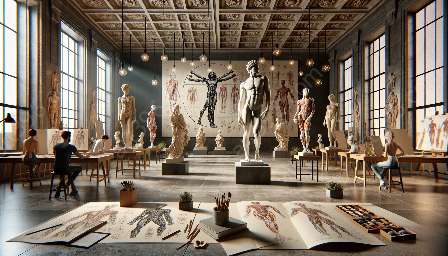Visual art has always been deeply rooted in the cultural and historical context of its time, which significantly impacts the portrayal of the human body. Across different civilizations and periods, artistic interpretations of the human body have been shaped by societal norms, religious beliefs, political ideologies, and technological advancements, reflecting the changing attitudes towards the human form.
Cultural and Historical Influences
In ancient civilizations, such as ancient Egypt and Greece, the human body was celebrated and idealized in art, reflecting the cultural emphasis on physical beauty, athleticism, and the divine. Greek sculptures, such as the Venus de Milo and the Discus Thrower, exemplify the idealized depiction of the human body, reflecting the values of harmony, balance, and perfection.
During the Renaissance, a period marked by a revival of classical art and intellectual values, the portrayal of the human body underwent a significant transformation. Artists, including Leonardo da Vinci and Michelangelo, pursued a deeper understanding of human anatomy, resulting in more realistic and anatomically accurate depictions. This shift was influenced by a renewed interest in science, humanism, and a greater understanding of the human body's structure and proportions.
Religious and Mythological Symbolism
Religious and mythological beliefs have also played a pivotal role in shaping the representation of the human body in art. In Christian art, the human body has often been depicted in sacred contexts, emphasizing themes of divinity, mortality, and redemption. The portrayal of saints, martyrs, and biblical figures reflected the spiritual ideals and religious narratives of the time, illustrating the cultural significance of the human form in religious iconography.
Similarly, in Asian art, depictions of the human body were influenced by Buddhist and Hindu beliefs, emphasizing spiritual enlightenment, inner harmony, and the interconnectedness of the human form with nature. Whether in the serene sculptures of Buddha or the vibrant imagery of Hindu deities, the portrayal of the human body resonated with the philosophical and spiritual traditions of the region.
Political and Social Commentary
Artistic interpretations of the human body often served as a means of expressing political ideologies and social commentary. Throughout history, artists have used the human body as a vehicle for conveying messages of power, oppression, resistance, and identity. In the 20th century, movements such as surrealism and cubism challenged traditional norms of representation, offering fragmented and distorted views of the human body that reflected the tumultuous and fragmented nature of the modern world.
Furthermore, artists have addressed issues of gender, race, and sexuality through their depictions of the human body, reflecting the evolving social attitudes towards identity and diversity. Artistic anatomy, which encompasses the study and representation of the human body's physical structure and musculature, has enabled artists to convey a deeper understanding of the body's form and movement, transcending mere visual representation to capture the essence of human experience.
Contemporary Perspectives
In the contemporary art world, the portrayal of the human body continues to evolve, reflecting a diverse range of cultural, social, and technological influences. Artists utilize new media, digital technologies, and interdisciplinary approaches to explore the complexities of the human body, challenging traditional notions of representation and beauty.
From the provocative installations of performance art to the innovative use of materials and the body itself as a medium, contemporary artists push the boundaries of artistic interpretations of the human body, inviting viewers to confront their own perceptions and biases. As the world continues to undergo rapid cultural and technological changes, the portrayal of the human body in visual art serves as a dynamic reflection of the ever-shifting landscape of human experience.

